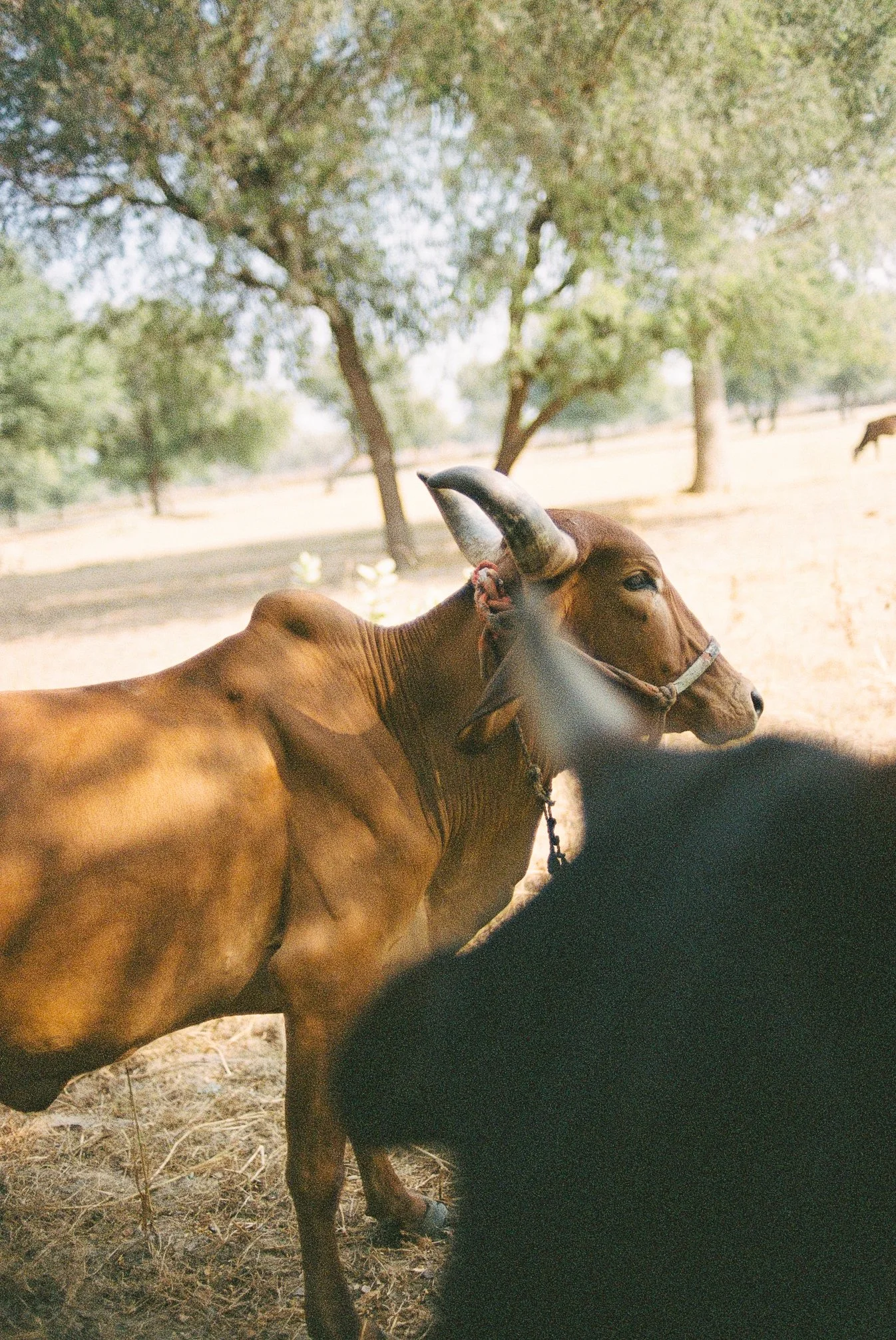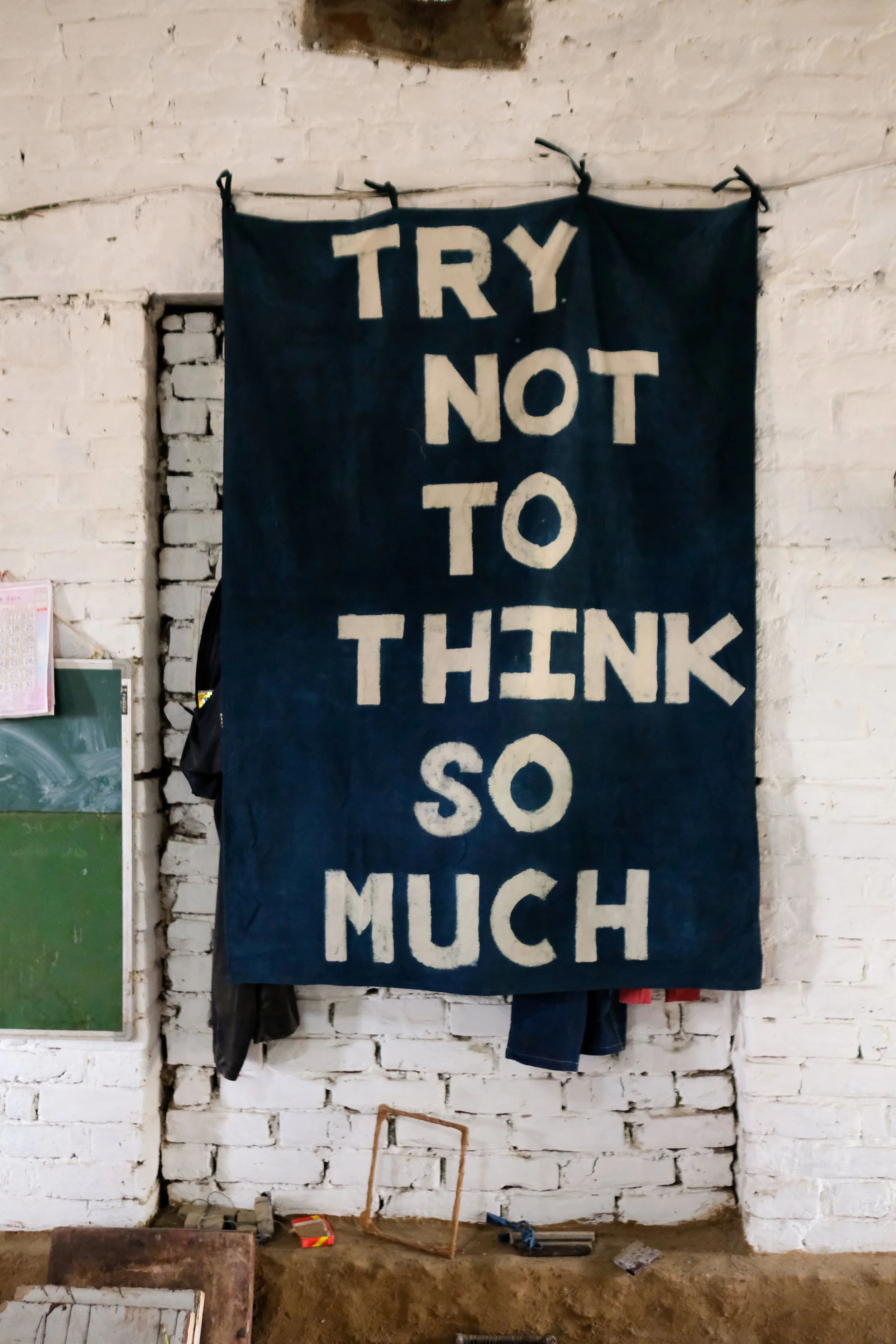Partner Spotlight: Wabisabi Project
Written by Katerina Knight
Photos by Luna Antonia Arboleda
As you drive out southwest of Jaipur, toward Bagru, away from urban city bustle, the bright sights and sounds fading into a wide expanse of rural farmland, fresh air, roaming herds of cattle, antelope, and camels, birds sweeping the sky – a sense of calm takes its place. It’s here, on the periphery, that you will find the workshop of Wabisabi Project – a studio devoted to preserving the legacy of traditional block printing and natural dyes.
“We were clear from the start,” says co-founder Avinash Mauyra, “the world didn’t need another block printing factory producing 2,000 metres a day.”
Founded in 2017 by Avinash and Kriti Gupta, Wabisabi Project began with no inherited knowledge or ties to textiles or Bagru, the studio instead grew from their deep authentic intuition, following serendipity, and committing themselves to the time it takes to learn ancient craft knowledge.
“Neither of us come from a craft background,” Avinash explains. “Kriti is a painter with a fine arts background, and I self-trained in graphic design.” Their paths crossed in a community kitchen in Jaipur that Avinash co-organised with friends, where they would cook and offer food to the local people, it was an experiment in the gift economy. Not long after meeting, the duo began collaborating on design projects. Then came a turning point: an interior design commission for a local hotel. “That project took us to Bagru, because we needed to source block-printed textiles. The deeper we went, the more we fell in love with the process and its history.”
Though the hotel project eventually fell through, something else had taken root. They were introduced to Jajam – a traditional communal floor textile once central to Rajasthani village life. “We’d already bought the raw cloth and fell in love” Avinash says, “so we decided to use that as the starting point and founded our studio: Wabisabi Project.”
Wabisabi’s workshop sits just outside Bagru and was once a poultry farm. “Its a little rough around the edges," Avinash says, "but that’s how we like it."
Slightly away from the traditional block print community clusters this gave them space to experiment, to fail, and to listen. “There are approximately 350 families in Bagru practicing the craft for generations,” says Avinash. “And we were two people with no background in textiles, trying to figure it out from scratch, being slightly away gave us the freedom to learn the craft at our own pace. It became a kind of cocoon where we could quietly lay the foundations of our practice.”
They began travelling across Rajasthan and Gujarat, documenting recipes, listening to master printers and dyers, and referencing old books and oral histories. “Sometimes we’d spend months on one process, never arriving at the ‘right’ result. It was like trying to piece together memory itself.”
Their process is methodical but also equally intuitive. Avinash describes it as “working alongside nature, not against it.” The wind dictates the drying speed, the sun sets the rhythm, and the monsoon slows everything down.
Wabisabi remains a small studio, with just four additional team members, three of whom are skilled craftsmen. The studio reflects the handprints of their artisans “If it smells like fermentation, so be it. If the floors are stained, so be it. That’s the reality of natural dyeing, it’s alive.”
“Our routine is shaped by what the day offers – sun, wind, temperature,” Avinash says. “Some days are slow. Others, fast. And sometimes everything stops because nature tells us to pause.” What emerges is a quiet rhythm of dyeing, printing, washing, and resting—the cloth, the self, the studio. “We try to stay in harmony with both the material and the emotional state of the makers,” says Avinash. “These are humans, not machines.”
But Wabisabi is more than a printing workshop, at its heart, the studio is about building community, both locally and globally.
Natural dyes are at the core of their practice, “Initially we explored everything – leaves, roots, fruit peels from all over India. But eventually we slowed down and began looking closer,” says Avinash.
They began to prioritise dyes from local flora of Rajasthan, such as acacia stems for brown, marigold flowers, madder root for red, iron scrap for black. Red and black are the historic colours of this region. Madder is a particularly demanding dye, it responds differently based on water mineral content, cloth, even weather. “But working with it taught us patience and precision. That became foundational to our practice.”
Their philosophy is one of learning by unlearning, of slowing down to see. “Both Kriti and I were raised in cities. Our formal education taught us discipline. But nature doesn’t work like that. It taught us to surrender.”
Of all the discoveries on their journey, Jajam has been the most transformative. Once found in almost every village, Jajam is a large hand-block printed floor cloth, used during festivals, weddings, and gatherings. “It wasn’t just a textile,” Avinash explains, “it was a communal space. People sat, played games, shared food—it was the literal and symbolic ground for social life.”
Wabisabi is reviving Jajam in its traditional form, using the same complex, 21-day process once followed by generations of craftsmen:
Soaking – the raw grey cotton overnight to loosen impurities
Boiling – in copper to purify it further
Beating – it clean by dhobis (washermen) on stone slabs
Applying – an oil emulsion of castor oil, cow dung, and khar to open the fibres
Resting – for 8–10 days
Washing and sun-drying – followed by a harda (myrobalan) treatment to prepare for dyeing
Block printing – with red (madder) and black (iron scrap fermentation)
Dyeing and drying – again to set the design
Each step is intricate, each one critical. “This process involves five communities, fifteen stages, and three weeks,” Avinash says. “There’s no shortcut.”
Their first body of work around Jajam culminated in a landmark 2018 exhibition at the Anokhi Museum of Hand Printing. Supported by Anokhi’s founder Rachel Bracken-Singh, the exhibition Rediscovering Jajam, brought together historic Jajam pieces, artisans, and stories from across Rajasthan.
“To coincide with the show we hosted a community event, Jajam Baithak, meaning a space to gather,” says Avinash. “There were artisans, families, craft researchers, and students all sitting on a specially commissioned Jajam in the museum courtyard, talking, eating, playing games. It was beautiful.”
The accompanying short film, co-produced with the museum, went on to win the 66th Indian National Film Award for Best Promotional Film.
Teaching both online and in-person has become a powerful extension of Wabisabi’s mission. “We realised that we’re often bridging two worlds,” Avinash reflects, “the world of traditional craftspeople, and the world of learners who aren’t from craft families.”
“Over the last nine years of practicing, a lot of the knowledge of block printing has been internalised by us through repetition of process, it becomes muscle memory,” explains Avinash. “But through the questions our participants ask – whether they’re artists, designers, scientists, researchers or just curious people – they help us revisit and relive the sensorial experience as a novice.”
“It is not just about passing on a technique. It’s about keeping the conversation alive.” So as modern life distances people further from craft and community, Wabisabi Project offers a place where time slows, hands work, and people come together on common Jajam ground.
Words by Katerina Knight and photos by Luna Antonia Arboleda for Thread Caravan.








